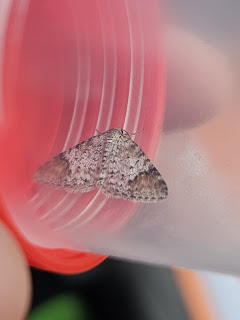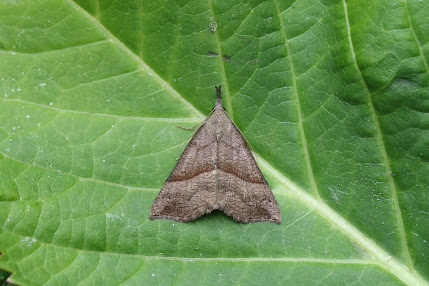Those that know of the infamous RSPB site, located on the East Coast of Yorkshire, will without doubt have heard of it for it's seabirds - and rightly so! Situated on the face of a towering 400ft high, chalk cliff, 500,000 of the UKs seabirds call it home. Perched on ledges no more than a few inches wide are birds such as Razorbills, Guillemots and Kittiwakes. The natural sea arch of Staple Newk and the surrounding cliff is residence to a large portion of the Gannet colony - some 25,000 strong; making it the largest mainland colony of Gannets in the UK. The real draw for most visitors are of course the Puffins. Hidden away, utilising the cracks and the crevices, these "clowns of the sea" draw people from across the world, all in the hope of stealing that glimpse of those orange feet & beak.
However despite all of this hustle and bustle that occurs mainly between April & July, it comes as no surprise that we are here for the Moths. The habitat offers some diversity in the form of Coastal Grassland, Scrubland with surrounding Farmland. Its location, jutting out approximately 4 miles further than that of the main coastline above and below it means that on the right night, with the right conditions it can be a hotspot for picking up some migratory species as well.
My ability to record at RSPB Bempton Cliffs has dropped off since last year mainly due to the fact that I no longer work there, having left in September 2024. Working there, generally 4 out of 5 days a week, throughout the whole summer, afforded many an opportunity to get the moth trap out with some good results. Despite it being more of a challenge to find the time, I want to ensure I can make the most of any opportunities that do offer themselves. The 27th, on paper was mixed. The positives being partially cloudy, with highs of 26c & a low of 20c. The negative was the wind - SW 14mph with gusts of potentially 35mph were forecasted - and they weren't too far wrong. Would this affect the results - time will tell.
 |
| View across the fields, towards the Clifftop |
I have made some amendments to how the data is presented which will hopefully be a little less on the eyes & have also included some additional information for new recorders such as Flight Seasons of moths, to give you an idea of when these species can generally be observed. Let's look at the highlights of which for this blog will be the most recorded moths for this session - however please do take a look at the notable records towards the end for some extra facts.
Firstly, the moth that was observed the most. For those that record regularly, it probably doesn't shock you that it was the Large Yellow Underwing.
 |
| Large Yellow Underwing |
Large Yellow Underwing (Noctua pronuba)
Size: 21-26mm forewing.
Flight Season: June-November
Larval Foodplant: Herbaceous plants & Grasses
Total Records: 108,033 Total Specimens: 1,965,901
Confusion Species: Lunar Yellow Underwing & Lesser Yellow Underwing
This variable looking moth was recorded 40x and made up just under 1/5th of the nights moths. This abundant and widespread moth, makes itself well known at this time of the year, with counts on certain nights reaching into the several hundreds. At RSPB Bempton Cliffs during an event over 2 days in 2023, 345 specimens of Large Yellow Underwing were recorded by Allan Rodda & myself. In 2024, Mike Coverdale recorded 298 in a single evening on the reserve too. Without doubt the record holder of "Most recorded moth in Yorkshire" with nearly 2 Million specimens - of which just under 7.5% of those were recorded in 2023 - a bumper year for LYU!
Secondly we have Marbled Minor Agg. - another one of these where multiple species without dissection, must be recorded as aggregate - Agg. (A combination of Marbled Minor, Tawny Marbled Minor & Rufous Minor). The current record in a single session for this moth, at this site is 97 - 06/07/2019.
 |
| Marbled Minor Agg. |
Size: 11-13mm forewing
Flight Season: May-July
Larval Foodplant: Grasses
Total Records: 28,629 Total Specimens: 106,593
Confusion Species: n/a
The 3rd moth on the list comes in the form of Dark Arches. 13 were recorded during this session. It is another very common moth within Yorkshire - securing 3rd place last year despite a 20% decrease on numbers from 2023.
.JPG) |
| Dark Arches |
Size: 19-26mm forewing
Flight Season: June-August
Larval Foodplant: Grasses
Total Records: 61,087 Total Specimens: 470,427
Confusion Species: n/a
This abundant and widespread resident, is a regular appearance in the trap over the summer months in most places across Yorkshire with only a few small gaps on the distribution map. Although predominantly a summer species, there are signs that a small, second generation is starting to appear and can generally be seen between September & November. The record for a single session on this site was back on the 24th July 2013 when 121 were recorded.
The next moth in terms of numbers was Dark/Grey Dagger with 10. We have gone into detail about this moth in a previous blog (Marvellous Moths - Introduction) and how the specific species can't be determined without dissection as an adult or finding larvae. If you wish to read more then, please do head back to the blog mentioned above. The moth we will move onto was recorded 9x and will actually make a good comparison to our previous moth - we will look at Light Arches.
 |
| Light Arches |
Size: 18-23mm forewing
Flight Season: June - August
Larval Foodplant: Grasses
Total Records: 14,195 Total Specimens: 43,179
Confusion Species: Reddish Light Arches & Pale Pinion
Light Arches is described as a common & widespread resident of Yorkshire, however is much less prevalent than it's counterpart above. This species favours areas of dry grassland making somewhere like Bempton a good habitat. Whilst this moth can be attracted to light, it is more frequent at sites using sugar - see: (https://butterfly-conservation.org/news-and-blog/a-recipe-for-moths-sugaring-wine-roping). Numbers did peak in 2019 for Light Arches with 2,953 specimens from 716 records, however these numbers have continued to decline since then with only 567 specimens from 349 records in 2024. The site record for Light Arches is 76, recorded on 17/07/2023.
Our final in depth moth of the blog will be the Flame. This moth was recorded 7x during this session.
 |
| Flame (File Photo 2023) |
Size: 14-16mm forewing
Flight Season: June - July & September (2nd Brood)
Larval Foodplant: Herbaceous plants
Total Records: 22,680 Total Specimens: 73,173
Confusion Species: Shuttle-Shaped Dart
Flame is described as a very common and widespread resident of Yorkshire. Records had been fairly stable over the last 10-12 years with there generally being between c.2,300 & 3,600 specimens recorded each year. However in 2024 there was a staggering 50% decrease in numbers, falling from 2,335 in 2023 down to 1,145. Flame also uses camouflage to try and protect itself from predators. Wrapping it's wings close to its body, combined with its stick like colourings it can perch on shrubs and branches appearing as a broken twig - rather than a tasty snack! The site record for Flame is 9 - recorded on 24/06/2023.
Other notable records:
• 8 Elephant Hawk-Moths were recorded which beats the previous site record of 3 on 16/07/2023.
• 4 Ghost moths (2♂ & 2♀) were recorded which beats the previous site record of 3 on 24/06/2023.
• Coronet was recorded for the first time on site - a localised moth that is slowly spreading across Yorkshire.
.JPG) |
| Coronet |
Overall 204 moths from 41 species were recorded overnight with some really good records for the reserve, highlighting that Bempton is not just all about the seabirds! I will leave you with the full list of species recorded below and as always the usual thanks, to those who help provide this data.
Moths Recorded:
Agapeta hamana 5
Anania perlucidalis 1
Barred Straw 1
Beautiful Golden Y 1
Bright-Line Brown-Eye 3
Brimstone 1
Broom Moth 2
Buff Arches 2
Buff Ermine 1
Burnished Brass 1
Chrysoteuchia culmella 4
Clay 7
Clouded Border 1
Common Swift 1
Common Wainscot 1
Coronet 1
Dark Arches 13
Dark/Grey Dagger 10
Drinker 5
Elephant Hawk-moth 8
Flame 7
Flame Shoulder 3
Ghost Moth 4
Heart & Dart 2
Large Yellow Underwing 40
Light Arches 9
Marbled Minor Agg. 30
Notocelia uddmanniana 1
Plain Golden Y 5
Setaceous Hebrew Character 2
Shuttle-Shaped Dart 2
Small Fan-Footed Wave 2
Small Magpie 1
Small Rivulet 3
Small Square Spot 4
Smoky Wainscot 5
Snout 1
Spectacle 6
Straw Dot 1
Udea lutealis 1
Uncertain/Rustic 6
If you have made it this far, thank you once again for taking the time out of your day to have a read - any suggestions on format etc are greatly appreciated.
Thanks must be added to the following organisations/websites where some of this data has been extracted:
All of the moth recorders, County Recorders, Vice County Co-ordinators and website admins who make all of this data - make sense!
























